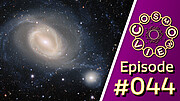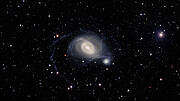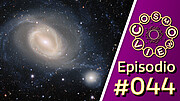Wider crop of the NGC 1512 image
Videos
DOE-funded Dark Energy Camera captures a pair of galaxies performing a gravitational duet
The interacting galaxy pair NGC 1512 and
NGC 1510 take center stage in this image from the US Department of
Energy-fabricated Dark Energy Camera, a state-of-the-art wide-field
imager on the Víctor M. Blanco 4-meter Telescope at Cerro Tololo
Inter-American Observatory, a Program of NSF’s NOIRLab. NGC 1512 has
been in the process of merging with its smaller galactic neighbor for
400 million years, and this drawn-out interaction has ignited waves of
star formation.
The barred spiral galaxy NGC 1512 (left) and its diminutive neighbor NGC 1510 were captured in this observation from the Víctor M. Blanco 4-meter Telescope.
As well as revealing the intricate internal structure of NGC 1512, this
image shows the wispy outer tendrils of the galaxy stretching out and
appearing to envelop its tiny companion. The starry stream of light that
connects the two galaxies is evidence of the gravitational interaction
between them — a stately and graceful liaison that has been going on for
400 million years. NGC 1512 and NGC 1510’s gravitational interaction
has affected the rate of star formation in both galaxies as well as
distorting their shapes. Eventually, NGC 1512 and NGC 1510 will merge
into one larger galaxy — a drawn-out example of galactic evolution.
These interacting galaxies lie in the direction of the constellation of Horologium
in the southern celestial hemisphere and are around 60 million
light-years from Earth. The wide field of view of this observation shows
not only the intertwined galaxies, but also their star-studded
surroundings. The frame is populated with bright foreground stars within
the Milky Way and is set against a backdrop of even more distant
galaxies.
The image was taken with one of the highest-performance wide-field imaging instruments in the world, the Dark Energy Camera (DECam).
This instrument is perched atop the Víctor M. Blanco 4-meter Telescope
and its vantage point allows it to collect starlight reflected by the
telescope’s 4-meter-wide (13-foot-wide) mirror, a massive,
aluminum-coated and precisely shaped piece of glass roughly the weight
of a semi truck. After passing through the optical innards of DECam —
including a corrective lens nearly a meter (3.3 feet) across — starlight
is captured by a grid of 62 charge-coupled devices (CCDs).
These CCDs are similar to the sensors found in ordinary digital cameras
but are far more sensitive, and allow the instrument to create detailed
images of faint astronomical objects such as NGC 1512 and NGC 1510.
Large astronomical instruments such as DECam are
custom-built masterpieces of optical engineering, requiring enormous
effort from astronomers, engineers, and technicians before the first
images can be captured. Funded by the US Department of Energy (DOE) with contributions from international partners, DECam was built and tested at DOE’s Fermilab,
where scientists and engineers built a “telescope simulator” — a
replica of the upper segments of the Víctor M. Blanco 4-meter Telescope —
that allowed them to thoroughly test DECam before shipping it to Cerro
Tololo in Chile.
DECam was created to conduct the Dark Energy Survey (DES),
a six-year observing campaign (from 2013 to 2019) involving over 400
scientists from 25 institutions in seven countries. This international
collaborative effort set out to map hundreds of millions of galaxies,
detect thousands of supernovae, and discover delicate patterns of cosmic
structure — all to provide much-needed details of the mysterious dark
energy that is accelerating the expansion of the Universe. Today DECam
is still used for programs by scientists from around the world
continuing its legacy of cutting-edge science.
More Information
NSF’s NOIRLab (National
Optical-Infrared Astronomy Research Laboratory), the US center for
ground-based optical-infrared astronomy, operates the international Gemini Observatory (a facility of NSF, NRC–Canada, ANID–Chile, MCTIC–Brazil, MINCyT–Argentina, and KASI–Republic of Korea), Kitt Peak National Observatory (KPNO), Cerro Tololo Inter-American Observatory (CTIO), the Community Science and Data Center (CSDC), and Vera C. Rubin Observatory (operated in cooperation with the Department of Energy’s SLAC National Accelerator Laboratory). It is managed by the Association of Universities for Research in Astronomy (AURA)
under a cooperative agreement with NSF and is headquartered in Tucson,
Arizona. The astronomical community is honored to have the opportunity
to conduct astronomical research on Iolkam Du’ag (Kitt Peak) in Arizona,
on Maunakea in Hawai‘i, and on Cerro Tololo and Cerro Pachón in Chile.
We recognize and acknowledge the very significant cultural role and
reverence that these sites have to the Tohono O'odham Nation, to the
Native Hawaiian community, and to the local communities in Chile,
respectively.
Links
- Photos of the Víctor M. Blanco 4-meter Telescope
- Videos of the Víctor M. Blanco 4-meter Telescope
- Photos of DECam
Contact:
Amanda Kocz
Communications Manager
NSF’s NOIRLab
Tel: +1 520 318 8591
Email: amanda.kocz@noirlab.edu
Source: NoirLab/News






